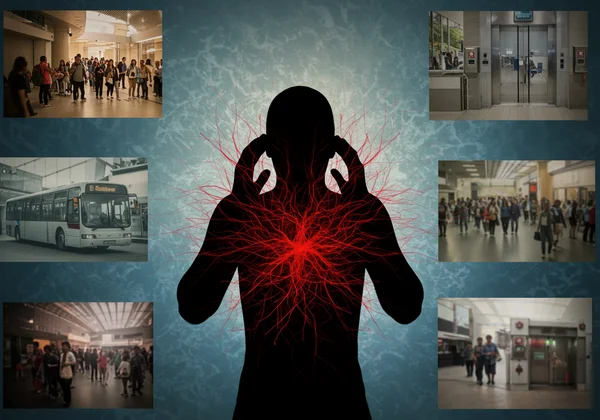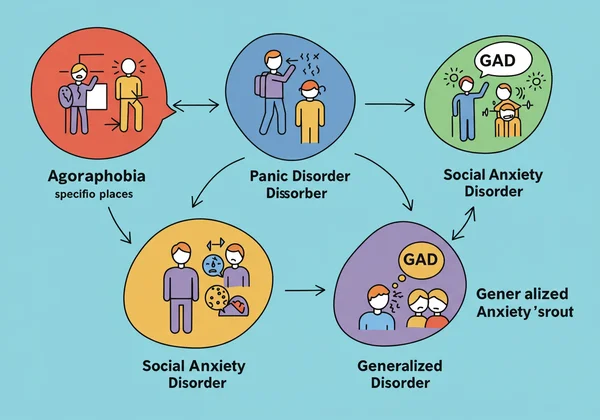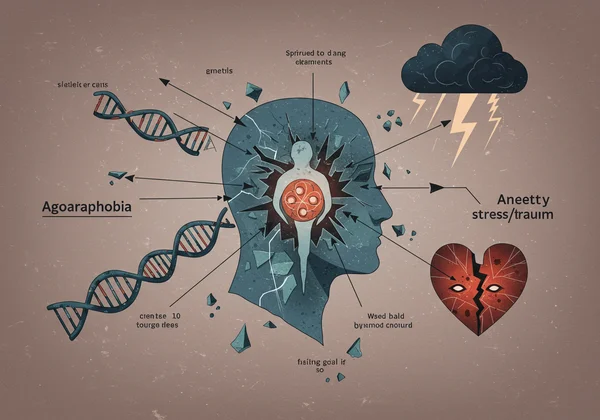What is Agoraphobia? Understanding Symptoms & Taking an Agoraphobia Test
Feeling overwhelmed by certain situations, like being in crowds, on public transport, or even in wide-open spaces? You're not alone, and that feeling has a name. Agoraphobia is a widely misunderstood anxiety condition, but gaining a clear understanding of what is agoraphobia is the first, most powerful step toward managing it. Many people find themselves wondering, how do I tell if I'm developing agoraphobia? This guide will provide a comprehensive, compassionate overview of what this condition truly is, how it differs from other forms of anxiety, and its formal diagnostic criteria. If you're seeking clarity, this is the place to start. For a personal first look at your symptoms, you can take our free test.
Understanding Agoraphobia: Beyond Just Fear of Open Spaces
A common misconception is that agoraphobia is simply a fear of open spaces. While that can be a part of it, the reality is far more complex. At its core, agoraphobia is an anxiety disorder characterized by an intense fear and avoidance of situations where escape might be difficult or help might be unavailable if you were to experience panic-like symptoms or other incapacitating or embarrassing symptoms. The fear is not of the place itself, but of the overwhelming feeling of being trapped and helpless within it.
This leads to a pattern of avoidance that can significantly shrink a person's world. The focus is on the potential for panic, not just the location. This distinction is crucial for understanding the experience of someone living with agoraphobia and finding the right path toward managing it.

Core Symptoms and Common Manifestations
The signs of agoraphobia can be both emotional and physical. The fear or anxiety is almost always triggered by exposure to a specific situation and is out of proportion to the actual danger posed. People experiencing these symptoms often feel a profound dread when anticipating these scenarios.
Common symptoms include:
- Fear of leaving home alone.
- Fear of crowds or waiting in a line.
- Fear of being in enclosed spaces, such as movie theaters, elevators, or small stores.
- Fear of being in open spaces, such as parking lots, bridges, or parks.
- Fear of using public transportation, like buses, planes, or trains.
The underlying fear is often that there will be no easy way to leave if panic symptoms flare up. This can lead to a significant fear of leaving the house, which is one of the most recognized aspects of the condition.

Common Situations & Triggers for Agoraphobia
Triggers are highly personal, but they generally fall into the categories listed above. A person might be fine in a small, familiar shop but experience intense anxiety in a large, crowded mall. They might be able to drive their own car but feel terrified on a bus. The key element is the perceived lack of control and the difficulty of escape. Over time, individuals may begin to avoid more and more places, leading to isolation. Recognizing these triggers is a key step in agoraphobia self-help.
Distinguishing Agoraphobia from Other Anxiety Conditions
It's easy to confuse agoraphobia with other anxiety disorders because their symptoms can overlap. However, the underlying reasons for the fear are different. Clarifying these distinctions is vital for accurate understanding and effective coping strategies. Understanding this distinction is key to moving forward.
Agoraphobia vs. Panic Disorder: A Critical Distinction
This is one of the most common points of confusion. Panic Disorder involves recurrent, unexpected panic attacks—sudden periods of intense fear that may include palpitations, pounding heart, sweating, trembling, and a feeling of impending doom. Agoraphobia can develop with or without a history of panic attacks.
When they co-occur, a person fears having a panic attack in a place they can't escape from, so they avoid those places. If agoraphobia occurs without panic disorder, the person fears other incapacitating symptoms, such as dizziness, falling, or public incontinence. The fear is tied to specific places and situations, whereas panic attacks in Panic Disorder can seemingly come out of nowhere.
How Agoraphobia Differs from Social Anxiety & GAD
Social Anxiety Disorder (SAD) involves a fear of social situations due to a worry about being judged, scrutinized, or embarrassing oneself in front of others. While someone with agoraphobia might avoid a crowded party, their fear is about being trapped and unable to escape a panic-like experience, not about the social judgment itself. A person with SAD might be perfectly comfortable traveling alone on a bus.
Generalized Anxiety Disorder (GAD) is characterized by persistent and excessive worry about numerous different things, like health, money, or work. This anxiety is more free-floating and not tied to specific situations like agoraphobia is. A person with GAD worries constantly, while a person with agoraphobia's fear is intensely focused on trigger environments.

Agoraphobia Diagnostic Criteria & Underlying Causes
For a formal diagnosis, mental health professionals rely on established criteria. Understanding these can help demystify the condition and provide a framework for discussing your symptoms with a doctor. This knowledge helps you have a more productive conversation about your symptoms.
Decoding the DSM-5 Criteria for Diagnosis
The Diagnostic and Statistical Manual of Mental Disorders, 5th Edition (DSM-5), is the standard guide used by clinicians. To meet the agoraphobia diagnosis criteria, a person must show marked fear or anxiety about two or more of the five classic situations mentioned earlier.
Furthermore, these conditions must be met:
- The individual actively avoids these situations, requires a companion, or endures them with intense fear.
- The fear is disproportionate to the actual danger.
- The fear, anxiety, or avoidance is persistent, typically lasting for 6 months or more.
- It causes clinically significant distress or impairment in social, occupational, or other important areas of functioning.
For an official overview of diagnostic standards, consult authoritative sources like the American Psychiatric Association, which publishes the DSM-5. If you recognize these patterns in yourself, taking an initial online agoraphobia test can be a helpful, private first step.
Exploring the Potential Roots: What Causes Agoraphobia?
There is no single answer to what causes agoraphobia. It’s believed to be a combination of factors, including:
- Genetics: Having a family history of anxiety disorders can increase risk.
- Temperament: Individuals with a naturally anxious or nervous disposition may be more susceptible.
- Stressful Life Events: Experiencing trauma, loss, or intense stress can act as a trigger.
- History of Panic Attacks: For many, agoraphobia develops after having one or more panic attacks and starting to fear having another.
Understanding these potential roots can provide important context for your experiences and is a vital step toward recovery.

Is There a Spectrum for Agoraphobia? Understanding Severity
Yes, agoraphobia exists on a spectrum. One person might feel anxious in malls and on planes but can manage daily life with some difficulty. Another person may be completely housebound, unable to step outside their front door without a trusted companion. The severity is determined by how many situations are avoided and how much the avoidance impacts the person's ability to live their life. Determining where you might fall on this spectrum helps you find the right level of support.
Understanding Agoraphobia: Your First Step Towards Clarity
By truly understanding agoraphobia, you transform a confusing cloud of fear into something definable and manageable. This knowledge gives you the power to begin reclaiming control over your life.
If what you've read today resonates with you, you're not at a dead end; you're at a starting point. Acknowledging your feelings is an act of strength. The next step is to gain more personalized insight. We invite you to use our free, confidential, and quick agoraphobia self-assessment. It’s designed to give you a preliminary look at your symptoms in just a few minutes, providing a foundation for self-awareness and a potential conversation with a healthcare professional.
Frequently Asked Questions About Agoraphobia
How do you test for agoraphobia?
A formal diagnosis is made by a mental health professional through a clinical interview, using the DSM-5 criteria. However, a great starting point is a self-screening tool. An online agoraphobia test like ours can help you organize your thoughts and assess your symptoms privately before speaking with a doctor.
What are the levels of agoraphobia?
Agoraphobia is often seen as existing on a mild, moderate, to severe spectrum. Mild cases might involve anxiety in a few specific situations but general daily functioning. Severe cases can result in a person being completely housebound. The level depends on the extent of avoidance and impairment in daily life.
Can you be agoraphobic and still leave the house?
Absolutely. Many people with agoraphobia can and do leave their homes. They may do so with great distress, only go to "safe" familiar places, or require a companion. Being able to leave the house doesn't invalidate the fear and anxiety experienced.
What can agoraphobia be mistaken for?
Agoraphobia is most often confused with Panic Disorder, Social Anxiety Disorder, and Generalized Anxiety Disorder. It can also be mistaken for specific phobias (like claustrophobia) if the fear is limited to only one type of situation. The key difference is that agoraphobia involves fear across multiple types of situations centered on the inability to escape. An am I agoraphobic quiz can help you reflect on these specific distinctions.